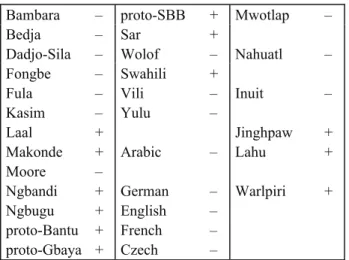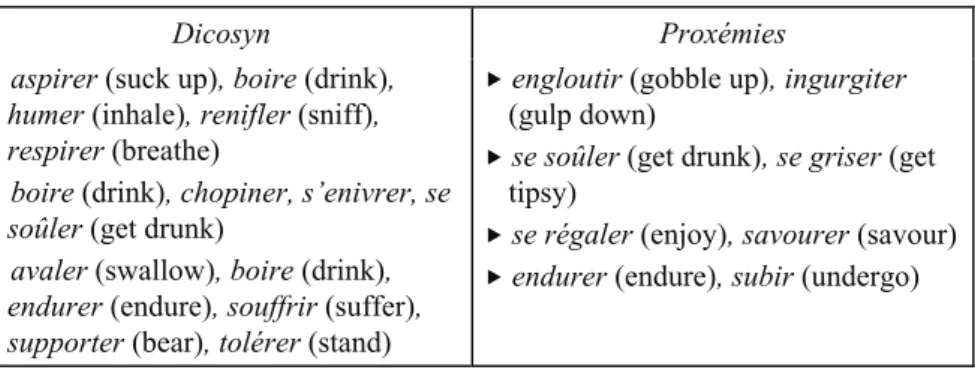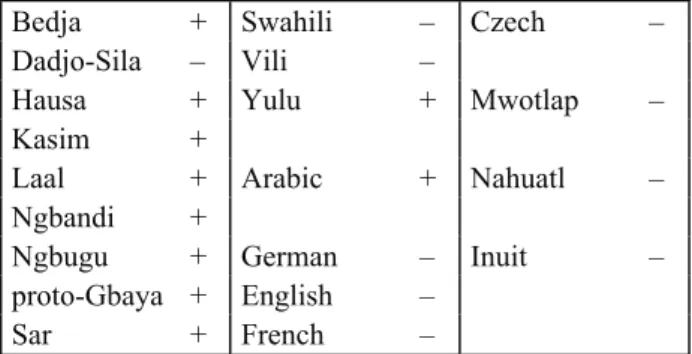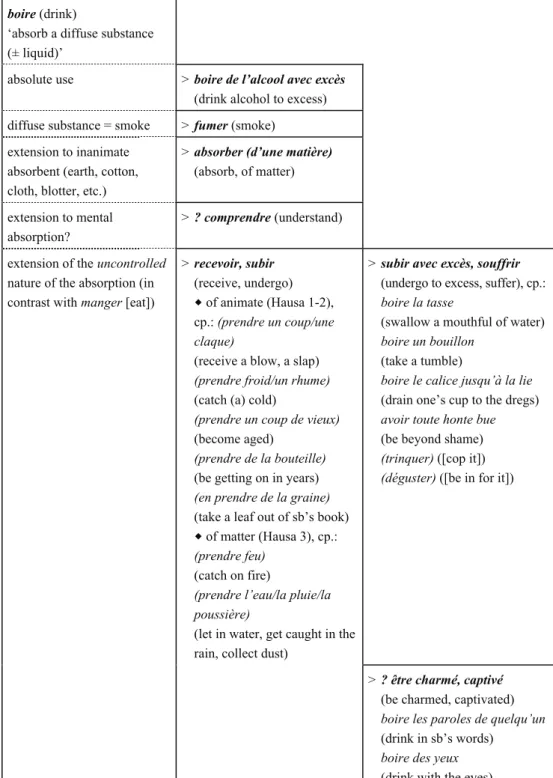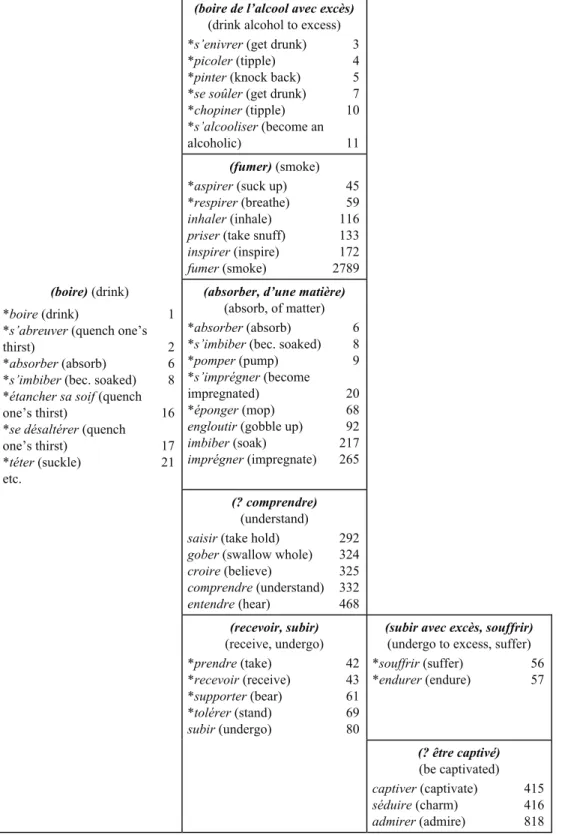HAL Id: halshs-00348132
https://halshs.archives-ouvertes.fr/halshs-00348132
Submitted on 17 Dec 2008HAL is a multi-disciplinary open access archive for the deposit and dissemination of sci-entific research documents, whether they are pub-lished or not. The documents may come from teaching and research institutions in France or
L’archive ouverte pluridisciplinaire HAL, est destinée au dépôt et à la diffusion de documents scientifiques de niveau recherche, publiés ou non, émanant des établissements d’enseignement et de recherche français ou étrangers, des laboratoires
From semantic change to polysemy. The cases of
”meat/animal” and ”drink”
Pascal Boyeldieu
To cite this version:
Pascal Boyeldieu. From semantic change to polysemy. The cases of ”meat/animal” and ”drink”. M. Vanhove. From Polysemy to Semantic Change. Towards a typology of lexical semantic associations, John Benjamins, pp.303-315, 2008, SLCS 106. �halshs-00348132�
Boyeldieu Pascal, 2008, From semantic change to polysemy. The cases of
“meat/animal” and “drink”, From Polysemy to Semantic Change. Towards a typology of lexical semantic associations (M. Vanhove ed.), Amsterdam/Philadelphia, John Benjamins (SLCS 106), 303-315.
From semantic change to polysemy: the cases of
‘meat/animal’ and ‘drink’
Pascal Boyeldieu (CNRS) Summary
The present section deals with the semantic affinities of two (groups of) concepts, namely ‘meat/animal’ and ‘drink’. Though not related, they contrast two different approaches in the domain of semantic parallels: while various data concerning ‘meat/animal’ naturally lead to a historical approach, revealing diachronic changes, the links regarding ‘drink’, chiefly exemplified in French, show a range of features involved in the semantic field of boire, that explain the diversity of its synchronic use.
Introduction
Even if we allude to ‘the moment when animals go drink’, the two topics of this contribution are not particularly related and are addressed successively and independently. The identity of the terms referring to both ‘meat’ and ‘animal’ was revealed by Greenberg (1983) as being a property of certain African languages. Here, we will see what their respective affinities in other languages are. The concept of ‘drink’ has been contrasted with that of ‘eat’ in a perceptive article by Gouffé (1966) concerning Hausa. We will particularly focus on the semantic relations of ‘drink’, however the reader will be invited to make a connection with the two contributions (E. Bonvini and C. Hénault-Sakhno) which deal with the semantic field of ‘eat’ in this same volume.
Nevertheless, besides their importance in the Africanist field, the confrontation of these two themes is interesting because it illustrates two complementary aspects of the issue of semantic parallels. In the case of ‘meat/animal’, the materials implemented indeed condition an essentially historical approach, based on considerations between the diachronic states of a same language or between present states of related languages, whereas the semantic field of ‘drink’ is apprehended in a strictly synchronic perspective, resting on the analysis of the current functioning of the observed languages. This double manifestation of semantic change and polysemy explains our choice of addressing the two topics jointly in a same article.1
1 This contribution has taken advantage of numerous personal papers (linguistic data, calculation of proxémies) of which the authors are cited ultimately. It has also benefited from several remarks done during the oral presentation of which I have not been able to explicitly mention the authors. I am grateful to them all for their help and collaboration.
I. ‘meat/animal’
First, let’s consider the case of the languages in which the two concepts are distinct. This is namely the situation in French, where animal is originally ‘living being’ (from the Latin anima ‘breath, life’) while viande is first ‘provisions, food’ (see Spanish vianda ‘provisions’) and then specializes in its present meaning after being replaced by nourriture (‘food’, initially ‘education’). The same semantic evolution is observed for German Tier ‘animal’, which originally refers to ‘breathing being’ (Germanic *deuza < Indo-European *dheusó-), and contrasts with Fleisch ‘meat, flesh’, English flesh or meat, all of them being derived from roots that mean ‘cut (up)’ and ‘measure’. Finally, in Inuit (Eskimo-Aleut), the term which designates ‘animal’ is based on the verb uuma- ‘be alive, have vigour’ whereas the term referring to ‘meat, food’ is linked to the verb nii- ~ niqi- ‘eat’. In all these languages ‘animal’ is commonly derived from ‘breathing, living being’. Other languages contrast terms referring to ‘meat’ and ‘animal’ in a different way. Nahuatl (Uto-Aztecan) yolcatl ‘animal’ is distinct from nacatl ‘meat, flesh’, the latter being linked to ‘fleshy’ and maybe also to ‘mushroom’. Dadjo-Sila (Eastern Sudanic) íiyè ‘meat, flesh’ (maybe related to ìiyèkè ‘give birth to, beget’?) contrasts with bèhíimè and màláayè (both from Arabic) ‘animal’.
Even within the Niger-Congo phylum, several languages have separate nouns for ‘animal’ and ‘meat’, although ‘game’ is often associated with the latter, e.g. Fula (barogel or kulle ‘animal’ vs. teewu ‘meat, flesh, game’), Wolof (mala ‘animal’ vs.
yapp ‘meat’), Bambara (dantafèn or bagan ‘animal’ vs. sogo, sogobu ‘meat, flesh’
and kungosogo ‘game’), Kasim (vrm ‘animal’, gvàr ‘wild animal’ vs. nn
‘meat, flesh, game’), Moore (dunga ‘animal’ vs. néémdo ‘meat, flesh, game’), Fongbe (kanlìn ‘animal’ vs. làn ‘meat, flesh, game’).
Vili, a Bantu language spoken by fishermen living on the Atlantic coast, also differs from some other Bantu languages (see below), as it contrasts cíbùlù ‘animal’ with mbìsì ‘meat, flesh’, which can be specified as mbìsí sìtù ‘bush meat (game)’ or mbìsí mbù ‘sea meat (fish)’. But in this group, such is the economic and cultural importance of fish that the only term mbìsì, by extension, most often refers to ‘fish’ (edible flesh par excellence) and is commonly substituted for its equivalent
lítÓÓngÒ.
In contrast to the situation known in the languages so far, Greenberg (1983) underlines the remarkable fact that several African languages have only one term referring both to ‘animal’ and ‘meat’. The author sees there a feature that is peculiar to the Niger-Congo phylum and suggests that the meaning ‘meat’ is first. In fact, this situation is observed in Ngbandi sà ‘animal, game, meat’, proto-Gbaya *sà’dì ‘meat, animal’ (distinct from *mùr ‘flesh’), Ngbugu giÀ ‘animal, meat’, Laal mèrÌm ‘animal, game, meat, flesh’ or in proto-SBB (Central Sudanic) *yida ‘meat, animal’ (whose reflexes are, among others, Sar då˜å˜ ‘animal (quadruped), game, meat’, but Yulu eˆj(Ë), which is restricted to the meaning ‘meat, flesh, pulp’ and contrasts with ºow(Ë) ‘animal’). The same ambivalence characterizes the proto-Bantu term *nyàmà ‘meat, animal’, even though some Bantu languages like
Makonde or Swahili developed a distinction that is expressed through different class attributions2 (table 1):
‘meat’
(gender 9/10: ‘various’) (gender 1/2: ‘living beings’)‘animal’
Swahili nyama/nyama m-nyama/wa-nyama
Makonde inaáma/dinyaáma ny-nyaáma/vá-nyááma Table 1: Reflexes of proto-Bantu *nyàmà in Swahili/Makonde
This semantic lack of differentiation however is not peculiar to the languages of the African continent. Matisoff (1978: 138) observes it in two Tibeto-Burman languages, Lahu and Jinghpaw:
“For most modern Western languages it does make sense to have two separate items for animal and meat/flesh. In the hunting cultures of backwoods SEA [South-Eastern Asia], these two concepts are often expressed by exactly the same word (e.g. Lahu r ‘animal; meat, flesh’; Jinghpaw shàn ‘flesh; deer; large game animal, as used for food’).”
and Wierzbicka (1992: 8) in Warlpiri (Pama-Nyungan):
“In the Australian Aboriginal language Warlpiri (Hale, Laughren, and Nash 1983-86) there is no general word for animals. Edible animals are distinguished from non-edible ones, the word for non-edible animals being the same as the word for meat.”
Whether in Africa, South-East Asia or Australia, it is reasonable to think that the importance of hunting and game as a source of food explains – if only historically – the terminological uniqueness of ‘animal’ (more precisely ‘quadruped’?) and ‘meat’. It is less clear whether, as Greenberg suggests, the meaning ‘meat’ is first. For information only, the presence or the absence of the polysemy ‘meat/animal’ in different languages are summed up in table 2:
Bambara – proto-SBB + Mwotlap –
Bedja – Sar +
Dadjo-Sila – Wolof – Nahuatl –
Fongbe – Swahili +
Fula – Vili – Inuit –
Kasim – Yulu –
Laal + Jinghpaw +
Makonde + Arabic – Lahu +
Moore –
Ngbandi + German – Warlpiri +
Ngbugu + English –
proto-Bantu + French – proto-Gbaya + Czech –
Table 2: Presence (+) or absence (–) of the polysemy ‘meat/animal’
2 The Bantu languages classes, often matched by genders to express a sg./pl. contrast, exhibit some semantic constants. In this particular case the lexicon that falls within gender 9/10 groups various, semantically heterogeneous nouns, but gender 1/2 very clearly includes a certain number of nouns referring to ‘living beings’.
Even though they are less illustrated, one has to mention historical semantic affinities which are observed between nouns referring to ‘animal’ and/or ‘meat’ and the name of a specific animal, presumably considered as a prototypical animal or as a meat supplier par excellence. This is the case of English deer, that results from a shift from the meaning ‘animal’ still attested in its German cognate Tier (see above). In southern Gbaya the reflex of *sà’dì disappeared and was substituted by the term nám ‘meat, animal’, which stems from proto-Gbaya *nám ‘buffalo’ (the latter is related to proto-Bantu *nyàmà ‘meat, animal’: southern Gbaya would actually have come back to the original meaning). As we saw earlier, in Jinghpaw,
shàn has the different meanings ‘flesh; deer; large game animal, as used for food’.
One last example is provided by the Bedja (Cushitic) term ša ‘meat’ that may be
linked to šÝa ‘heifer, cow’.3
More exceptionally the different SBB languages – that attest one or several of the following meanings – enable to identify a series of semantic shifts that ranges from ‘salt’ to ‘animal’ and can be explained among other things by the cultural importance of a type of sauce made from salt:
*ta•ø ‘salt (from plant)’ > ‘sauce (from salt)’ > ‘sauce (in general)’ > ‘meat’ > ‘animal’
The nature of the data that we were able to gather on the double concept ‘meat/animal’ has led to an essentially historical approach, concerning semantic affinities that are established and observed within the diachrony of a language or, failing that, within the synchrony of related languages. In general, the observed parallels stress the importance of the cultural factors as the best vector of meaning transfers during the history of languages.
As we will see now, the concept ‘drink’ reveals a polysemy which is more strictly synchronic, brought to the fore by the different contexts of its uses and by the affinities it has with lexical items of close meaning.
II. ‘drink’
The basic definition for the French verb boire (drink) is ‘absorb liquid’. However, some specific uses bring out values that are found in other languages. First, boire, in its absolute use, means ‘drink alcohol to excess’. Moreover, if ‘drinking’ is spontaneously considered to be the activity of an animate subject, it becomes an essentially passive process when applied to an inert matter (earth, cotton, etc.). In fact this passive, uncontrolled dimension of the value of boire (drink) is also sensitive, in the presence of an animate subject, in expressions like boire les
paroles de quelqu’un (drink in sb’s words), boire des yeux (lit. ‘drink with the
eyes’), boire la tasse (swallow a mouthful of water), boire un bouillon (take a tumble, lit. ‘drink a broth’), boire le calice jusqu’à la lie (drain one’s cup to the dregs), avoir toute honte bue (be beyond shame, lit. ‘have all the shame drunk’) – to be compared with the Russian expression ‘drink a glass of grief’. It is also corroborated by the similar connotations of two close terms like trinquer (clink
3 V. Blažek however thinks that this resemblance results from a convergence (M. Vanhove, pers. comm.).
glasses, in the meaning of ‘cop it, take the rap’) and déguster (taste, enjoy, in the meaning of ‘be in for it, not half have a rough time’).
These semantic components are logically found in the vertices that the semantic space of the Dictionnaire des synonymes (Dicosyn, Caen) as well as the calculation of the proxémies4 (B. Gaume) bring out (table 3):
Dicosyn Proxémies
f aspirer (suck up), boire (drink), humer (inhale), renifler (sniff), respirer (breathe)
f boire (drink), chopiner, s’enivrer, se soûler (get drunk)
f avaler (swallow), boire (drink), endurer (endure), souffrir (suffer), supporter (bear), tolérer (stand)
f engloutir (gobble up), ingurgiter (gulp down)
f se soûler (get drunk), se griser (get tipsy)
f se régaler (enjoy), savourer (savour)
f endurer (endure), subir (undergo)
Table 3: Semantic space and proxémies of ‘boire’
Moreover, Dicosyn shows a dimension of ‘inhalation’ (‘inhale’, ‘sniff’, ‘breathe’) and the proxémies a dimension of ‘pleasure’ (‘enjoy’, ‘savour’).
Several languages also have a polysemy ‘drink/smoke’, although the second meaning generally needs the expression of an explicit object (‘tobacco’). It is notably the case in several African languages. Thus, Kasim ñÒ, proto-Gbaya *no, Ngbandi nyÖ ‘drink, smoke’ (the formal resemblance of those languages, which belong to different branches of the Niger-Congo phylum, is not fortuitous). The same holds for Sar àñ¯ ‘drink (including gruel), swallow (egg), smoke, extract (a sticky matter from a plant: latex, gum)’, Yulu ÒøyË ‘drink, absorb, become saturated, smoke’, Ngbugu njø and Laal sÏr ‘drink, smoke’ (but Dadjo-Sila distinguishes wùràkè ‘drink’ and •èekè ‘smoke’). Bedja confirms the polysemy through two distinct verbs, gwÝa ‘drink, smoke’ and gwiham ‘take little sips,
swallow, smoke tobacco without inhaling’.
Classical Arabic has the same relation in ariba ‘1. drink, smoke (lit. ‘drink (the) smoke’); 2. tell lies about somebody; 3. be thirsty’. Different terms are traditionally linked to the same ŠRB root, although many of their meanings (in italics below) may be very far from those we are interested in here and we can’t assert that they are related:
araba ‘understand, hear, grasp through intelligence’ arbah ‘1. one time when one drinks; … 4. palm tree’
arrabah ‘1. land that produces plants but where there is no tree; 2. manner, way’
urbah ‘1. portion of drink drunk in one go (> French sorbet); 2. shade,
colour that stands out against a different background’
4 The proxémies, in which, of course, the synonyms come first, result from a calculation of the number of paths that are covered in order to link together two given entries of a dictionary, through a quotation in their gloss. The term proxemy, that we will keep in its French form throughout, was apparently made up by the American anthropologist E.T. Hall to refer to the physical distance between individuals in a social context.
arabah ‘1. little hole full of water; … 4. intensity of heat’
rib ‘1. who/which drinks; 2. weakness, languor; 3. moustache; …. 5.
vein in neck’
irb ‘1. fact of getting sb. to drink; 2. light mix of another colour, shade’
marab ‘1. place where one drinks or waters; ... 3. (fig.) mores, habits,
customs; ...’
marabiyyah ‘protuding barred window’ (> French moucharabieh) (because
one puts a container for drinks there?)
The presence or absence of a polysemy ‘drink/smoke’ are summed up in table 4:
Bedja + Swahili – Czech –
Dadjo-Sila – Vili –
Hausa + Yulu + Mwotlap –
Kasim +
Laal + Arabic + Nahuatl –
Ngbandi +
Ngbugu + German – Inuit –
proto-Gbaya + English –
Sar + French –
Table 4: Presence (+) or absence (–) of the polysemy ‘drink/smoke’
In an exemplary article devoted to Hausa, Gouffé (1966) analyzes, in a contrastive way, the respective semantic properties of two terms of this language that mean respectively ‘eat’ and ‘drink’ and thus shows the richness of their uses. Without dwelling on the concept ‘eat’ which is addressed elsewhere in this volume, I will quote in extenso several comments and illustrations taken from this article concerning the concept ‘drink’ and which seem extremely significant to me for our subject.
First of all, the author offers an analysis of the two terms ci(i) ‘eat’ and šaa ‘drink’ in semantic features that he identifies and contrasts as follows (table 5):
ci(i) ‘eat’ šaa ‘drink’
Human activity / physiological
“appropriation / alimentary / of solids” “appropriation / alimentary / of liquids” “appropriation / sexual / by male” “appropriation / sexual / by female”
Human activity / non-physiological
“appropriation / non physiological / exerted” “appropriation / non physiological / endured” Material world
“appropriation / material / exerted” “appropriation / material / endured”
Table 5: Semantic features of Hausa ci(i)/šaa (Gouffé 1966: 106)
Beyond the most common meaning of ‘absorb a solid/a liquid’, the two verbs contrast notably in the expression of the sexual intercourse experienced by a man or by a woman:
(1) yaa cii tà /he/ — /she/ ‘he possessed her sexually’
But the passive, endured dimension of ‘drink’ is more general and applies to many uses in what Gouffé names the ‘non physiological field’:
(2) “At the basic form, šaa contrasts with ci(i) insofar as the process of appropriation that it denotes is considered as the result of a pressure external to the subject, hence endured by it, and not as a voluntary acquisition that would only depend on its own initiative.” [...]
yaa šaa làaabaarìi ‘he has collected news (about it)’ (lit. ‘he has — the news’) [...] yaa šaa dàaRiyaa ‘he doubled up with laughter’ (lit. ‘he has — laughter’) [...] yaa šaa gàRii ‘he lived in the city for a long time’
and [contrasting with:] yaa ci gàRii ‘he conquered the city’ [...] yaa šaa kyauRoo ‘he got hit by an arrow’ [...]
yaa šaa Raanaa ‘he has been right in the sun’ (lit. ‘he has — the sun’) [p. 95-97]
or the ‘material field’ (inanimate subject):
(3) “Here again, the process denoted by šaa is indeed a process of appropriation: a substance A (the subject, in the linguistic message) is incorporated or absorbs another substance B (the object, in the linguistic message). But instead of being presented as resulting from a specific property of A, this absorption is envisaged as the product of B acting on A.” [...]
Ýàbinci yaa šaa Ýiskàa ‘the food has cooled down a little bit’ (lit. ‘the food has — the air’) [...]
bàRi Ýitàacen nàan yà šaa ‘let this wood dry up!’ (lit. ‘let this wood so that it — ’) [...]
littafìi yà šaa hannuu ‘the book was made dirty, worn’ (lit. ‘the book has — the hand’) [...]
[contrasting with:] Ýigiyàa taa ci K’afàssa ‘the rope has cut into its leg’ (e.g. of a horse) [p. 103-104]
The set of acceptations of ‘drink’ that we just envisaged is summed up in a synthetic diagram (see table 6) that attempts to identify various progressions from a central value (basic or initial?) that is defined as ‘absorb a diffuse substance, more or less liquid’. It is indeed this diffuse, pervasive and not controllable nature of the
absorbed matter that conditions the not necessarily voluntary characteristic of the
absorption and justifies, in my opinion, its possible extension to values which are explicitly passive.
A first link is established from this central value to the one of ‘drink alcohol to excess’. If this particular meaning results from an explicit lexical complement in Kasim ñÒ ... cÖ [drink ... act to excess] ‘get drunk’, it presupposes, in French, an absolute use of the verb, the aspect contrast taking on the two more specific values of permanent state ‘be an alcoholic’ (imperfective: il boit [he drinks], il buvait [he used to drink]) and of punctual process ‘get drunk’ (perfective: il a bu [he drank, he has drunk], il avait bu [he had drunk]). Other languages resort to a change of diathesis: in Nahuatl, the reflexive use of the verb i or on-i ‘drink’ takes on the value ‘drink one’s own substance, drink up the price of one’s slavery’; the English construction be drunk, the German betrunken sein, and the Czech být opilý, are all passive (lit. ‘be drunk’).
The ‘diffuse substance’ characteristic and its possible application to smoke proba-bly explains the ambivalence ‘drink/smoke’ that is observed in some languages.5
Indeed the term applies exactly to the inhalation of smoke and not to the other ways of consuming tobacco (pinch of snuff, chew).
Extending to inanimate absorbents, ‘drink’ also concerns all the granular, fibrous and porous matters that are likely to attract a liquid with which they are put in contact.
What is less certain is the relation with ‘understand’ (Arabic), which could be explained as being the result of a process of ‘mental absorption’? The link would then be rather comparable to the one observed between the two senses, whether literal or figurative, of the French term gober (‘swallow (whole)’, fig. ‘believe’). As we said, the uncontrolled characteristic of absorption explains the possible extensions of ‘drink’ in the sense of ‘receive, endure’, as they are illustrated notably in Hausa. Let’s note that French has, in similar situations, several expressions involving the verb prendre (take), which then cannot be put in the passive, but whose subject is eminently passive, whether it is animate (prendre un
coup (receive a blow), prendre froid (catch cold), prendre de la bouteille ‘be
getting on in years’ (lit. ‘take bottle’), etc.) or inanimate (prendre feu (catch on fire), prendre la poussière (collect dust), etc.).
This value ‘receive, endure’ finally leads to two closely related fields through the dimensions of ‘excessiveness’ and ‘capture’ that it virtually involves. Hence the meaning of ‘endure to excess, suffer’ which is illustrated in the French expressions
boire la tasse (swallow a mouthful of water), boire le calice jusqu’à la lie (drain
one’s cup to the dregs), etc. (see as well the figurative senses of trinquer [cop it] and déguster [be in for it]) and also maybe the meaning of ‘being charmed, captivated’ in boire les paroles de quelqu’un (drink in sb’s words) and boire des
yeux (lit. ‘drink with the eyes’). Concerning this last acceptation, it is probably not
insignificant, that the philtre that is supposed to capture the feelings of the person it is administered to, is generally presented as a beverage.
Finally we will go over the different meanings that have just been presented by illustrating them, for French, by the proxémies of boire (drink) as they were calculated by B. Gaume (see table 7).6 These proxémies show that fumer (smoke)
(2789) is in this case extremely far from boire, but on the other hand prendre (take) (42), recevoir (receive) (43), supporter (bear) (61) and tolérer (stand) (69) are more or less close to it, as well as souffrir (suffer) (56) and endurer (endure) (57) (all these terms are, by the way, considered as synonyms of boire (drink) by the
Dicosyn). The proximity is less clear for saisir (grasp) (292), comprendre
(understand) (332), entendre (hear) (468) and captiver (capture) (415), séduire (seduce) (416), admirer (admire) (818).
5 Concerning Gbaya, which has the polysemy ‘drink/smoke’, Y. Moñino (pers. comm.) points out an interesting physiological conception: “For the Gbaya, the path of water in the body is the same as the path of smoke: they go into the lungs and from there into the bladder. Solid food goes into the stomach and the intestines.”
6 See note 4 above. The corpus from which the proxémies were calculated consists of about 10.000 verbs.
boire (drink)
‘absorb a diffuse substance (± liquid)’
absolute use > boire de l’alcool avec excès (drink alcohol to excess) diffuse substance = smoke > fumer (smoke)
extension to inanimate absorbent (earth, cotton, cloth, blotter, etc.)
> absorber (d’une matière) (absorb, of matter) extension to mental
absorption?
> ? comprendre (understand) extension of the uncontrolled
nature of the absorption (in contrast with manger [eat])
> recevoir, subir (receive, undergo)
of animate (Hausa 1-2), cp.: (prendre un coup/une claque)
(receive a blow, a slap) (prendre froid/un rhume) (catch (a) cold)
(prendre un coup de vieux) (become aged)
(prendre de la bouteille) (be getting on in years) (en prendre de la graine) (take a leaf out of sb’s book)
of matter (Hausa 3), cp.: (prendre feu)
(catch on fire)
(prendre l’eau/la pluie/la poussière)
(let in water, get caught in the rain, collect dust)
> subir avec excès, souffrir (undergo to excess, suffer), cp.: boire la tasse
(swallow a mouthful of water) boire un bouillon
(take a tumble)
boire le calice jusqu’à la lie (drain one’s cup to the dregs) avoir toute honte bue (be beyond shame) (trinquer) ([cop it]) (déguster) ([be in for it])
> ? être charmé, captivé (be charmed, captivated) boire les paroles de quelqu’un (drink in sb’s words)
boire des yeux (drink with the eyes)
(boire de l’alcool avec excès) (drink alcohol to excess) *s’enivrer (get drunk) 3 *picoler (tipple) 4 *pinter (knock back) 5 *se soûler (get drunk) 7 *chopiner (tipple) 10 *s’alcooliser (become an alcoholic) 11
(fumer) (smoke) *aspirer (suck up) 45 *respirer (breathe) 59
inhaler (inhale) 116
priser (take snuff) 133
inspirer (inspire) 172
fumer (smoke) 2789
(boire) (drink) *boire (drink) 1 *s’abreuver (quench one’s
thirst) 2
*absorber (absorb) 6 *s’imbiber (bec. soaked) 8 *étancher sa soif (quench one’s thirst) 16 *se désaltérer (quench one’s thirst) 17 *téter (suckle) 21 etc.
(absorber, d’une matière) (absorb, of matter) *absorber (absorb) 6 *s’imbiber (bec. soaked) 8 *pomper (pump) 9 *s’imprégner (become impregnated) 20 *éponger (mop) 68
engloutir (gobble up) 92
imbiber (soak) 217
imprégner (impregnate) 265 (? comprendre)
(understand)
saisir (take hold) 292
gober (swallow whole) 324
croire (believe) 325 comprendre (understand) 332 entendre (hear) 468 (recevoir, subir) (receive, undergo) *prendre (take) 42 *recevoir (receive) 43 *supporter (bear) 61 *tolérer (stand) 69 subir (undergo) 80
(subir avec excès, souffrir) (undergo to excess, suffer) *souffrir (suffer) 56 *endurer (endure) 57 (? être captivé) (be captivated) captiver (captivate) 415 séduire (charm) 416 admirer (admire) 818
[N.B. The words preceded by * are given as synonyms of boire in the Dicosyn (Caen)]
Quoted languages and sources
Arabic (classical) M. Vanhove: quotations from Dozy 1968, Kazimirski
1860 and O. Bencheikh (pers. comm.)
Bambara (Mande/Mali) E. Bonvini (pers. comm.)
Bantu (see Makonde, Swahili, Vili)
Bedja (Cushitic/Sudan) M. Vanhove: (pers. comm.) and quotations from Roper
1928 and V. Blažek (pers. comm.)
Dadjo-Sila (Eastern Sudanic/Chad) P. Boyeldieu
English Onions 1966
Fongbe (Kwa/Benin) E. Bonvini (pers. comm.)
French Le Nouveau Petit Robert
Dictionnaire historique de la langue française Dictionnaire des synonymes (Dicosyn, Caen) Proxémies: B. Gaume (pers. comm., 2004 and website DiLan)
Fula (Atlantic/Western Africa) E. Bonvini (pers. comm.)
Gbaya (Ubangian/CAR) and proto-Gbaya Y. Moñino (pers. comm.)
German Kluge 1960
Hausa (Chadic/Nigeria) Gouffé 1966
Inuit (Eskimo-Aleut/Groenland) N. Tersis (pers. comm.)
Jinghpaw (Tibeto-Burman/Myanmar) Matisoff 1978
Kasim (Gur/Burkina Faso) E. Bonvini (pers. comm.)
Laal (Adamawa?/Chad) P. Boyeldieu
Lahu (Tibeto-Burman/China) Matisoff 1978
Makonde (Bantu/Tanzania) S. Manus (pers. comm.)
Moore (Gur/Burkina Faso) E. Bonvini (pers. comm.)
Mwotlap (Malayo-Polynesian/Vanuatu) A. François (pers. comm.)
Nahuatl (Uto-Aztecan/Mexico) M.-N. Chamoux (pers. comm.)
Ngbandi (Ubangian/CAR, DRC) Lekens 1952
Ngbugu (Ubangian/CAR) P. Boyeldieu
Sar (Central Sudanic/Chad) Palayer 1992
SBB (Sara-Bongo-Bagirmi) (Central
Sudanic/Central Africa) (see Sar, Yulu) Boyeldieu, Nougayrol & Palayer 2006
Swahili (Bantu/Eastern Africa) S. Manus (pers. comm.)
Vili (Bantu/Congo) Y. Moñino (pers. comm.)
Warlpiri (Pama-Nyungan/Australia) Hale, Laughren & Nash 1983-86, quoted from Wierzbicka 1992
Wolof (Atlantic/Senegal) E. Bonvini (pers. comm.)
Yulu (Central Sudanic/CAR, Sudan) P. Boyeldieu
References
Boyeldieu, P., Nougayrol, P. & Palayer, P. 2006. Lexique comparatif historique des langues sara-bongo-baguirmiennes. Electronic document.
[http://sumale.vjf.cnrs.fr/SBB/]
Dictionnaire des synonymes (Dicosyn, Université de Caen). [http://elsap1.unicaen.fr/dicosyn.html]
Dictionnaire historique de la langue française 1992. Paris: Dictionnaires Le Robert. DiLan (Groupe de recherche pluridisciplinaire sur la modélisation en linguistique ).
[http://dilan.irit.fr/]
Dozy, R. 1968 (1st ed. 1881). Supplément aux dictionnaires arabes. Beyrouth: Librairie du Liban.
Gaume, B. 2004. Balades aléatoires dans les Petits Mondes Lexicaux. I3 Information Interaction Intelligence, vol. 4, n° 2, CEPADUES Edition.
Gouffé, C. 1966. « Manger » et « boire » en haoussa. Revue de l’école nationale des langues orientales 3: 77-111.
Greenberg, J.H. 1983. Some Areal Characteristics of African Languages. In Current Approaches to African Linguistics, vol. 1, I.R. Dihoff (ed.), 3-21. Dordrecht: Foris Publications.
Hale, K.L., Laughren, M. & Nash, D. 1983-86. Warlpiri Dictionary. Unpublished drafts, Massachusetts Institute of Technology.
Kazimirski, A. de. 1860. Dictionnaire arabe - français contenant toutes les racines de la langue arabe, leurs dérivés, tant dans l’idiome vulgaire que dans l’idiome littéral, ainsi que les dialectes d’Alger et de Maroc. Paris: Maisonneuve & Cie.
Kluge, F. 1960 (1st ed. 1883). Etymologisches Wörterbuch der deutschen Sprache. Berlin: Walter de Gruyter & Co.
Le Nouveau Petit Robert. 1993. Paris: Dictionnaires Le Robert.
Lekens, B. 1952. Dictionnaire ngbandi (Ubangi - Congo belge). Tervuren: Musée Royal du Congo Belge.
Matisoff, J.A. 1978. Variational Semantics in Tibeto-Burman. Philadelphia: Institute for the Study of Human Issues.
Onions, C.T. (ed.). 1966. The Oxford Dictionary of English Etymology. Oxford: Clarendon Press.
Palayer, P. 1992. Dictionnaire Sar-Français (Tchad). Paris: Geuthner.
Roper, E.M. 1928. Tu BeÆawi¢. An Elementary Handbook for the Use of Sudan Government Officials. Hertford: Stephen Austin.
Wierzbicka, A. 1992. Semantics, Culture and Cognition, Universal Human Concepts in Culture-Specific Configurations. New York-Oxford: Oxford University Press.
